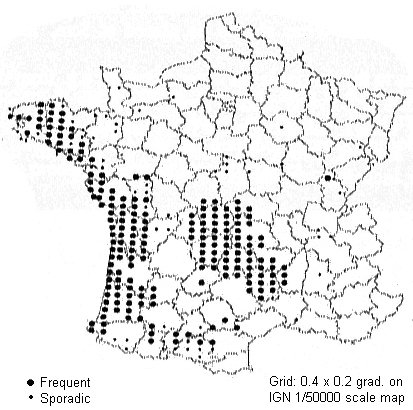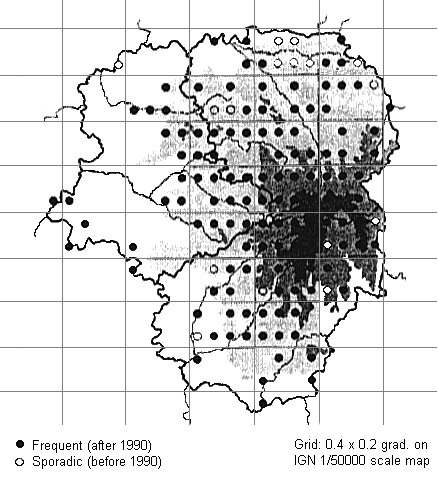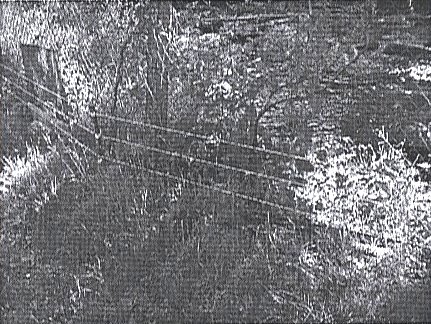 |
Last Update:
Thursday November 22, 2018
|
| [Home] |
|
Volume 20 Issue 1 Pages 1 - 56 (April 2003) Citation: Leblanc, F. (2003) Protecting Fish Farms from Predation by the Eurasian Otter (Lutra lutra) in the Limousin Region of Central France: First Results IUCN Otter Spec. Group Bull. 20(1): 45 - 48 Protecting Fish Farms from Predation by the Eurasian Otter (Lutra lutra) in the Limousin Region of Central France: First Results Frédéric Leblanc Mediateur Faune Sauvage, Limousin Nature Environnement e-mail: diclidurus.albus@wanadoo.fr
INTRODUCTION Though relatively scarce in France (Figure 1), the Eurasian otter (Lutra lutra) is quite widespread in the region of Limousin (Figure 2), resulting in a potential conflict with local fishfarmers (GAUTIER et. al., 1995; GMHL, 2000). In response to an inquiry from one of the fishfarmers in Corrèze (Central France) to 'Limousin Nature Environnement' (Contributing organisations: SFEPM, GMB, GMHL, IUCN; and funded by the 'Direction Régionale de l'Environnement du Limousin') led a study to determine effective methods of protecting fish stocks from otter predation. The aim was also to reduce the risk of illegal trapping and killing by fish farmers under threat from this protected species. The study period covered September 1999 to October 2001. Each of eight local fish farms, producing fish of the genus Salmonidae, suffered occasional stock losses through otter predation. Detailed behavioural observation of otters and testing of various protection methods was used to identify those considered most effective. Their selection and installation, however, depends on the type and location of the individual fish farms.
PRELIMINARY RESULTS AND RECOMMENDATIONS General protection methods: If used alone, security-type lighting systems, i.e. those fitted with automatic detection sensors, or repellents for carnivorous animals proved ineffective. A combination of techniques is therefore recommended:
Behavioural observations: During this study, a number of behavioural characteristics of Eurasian Otters were observed:
FURTHER WORK Providing that funding is forthcoming, the next step is to install the preventative measures on a fish farm. This will serve as both a demonstration model and educational aid for other local fish farmers and those across Europe requiring efficient deterrents against the predation of their stock by otters. Acknowledgements - I wish to thank the following people for their assistance in this work: René ROSOUX (SFEPM); Christian BOUCHARDY (SFEPM); Lionel LAFONTAINE (Groupe Mammalogique Breton/ SFEPM / IUCN Otter Specialist Group - France); Hélène JACQUES (SFEPM / IUCN Otter Specialist Group - France); Michaela BODNER (IUCN Otter Specialist Group - Austria); Aksel BO MADSEN (IUCN Otter Specialist Group - Denmark). Bob HUSSEY and Jo WILSON (RJTC-France) for their help with the translation into English. References Gautier, J.Y., Rosoux, R., Libois, R. (1995). La Loutre et le
Vison d'Europe. Actes du XVIIº Colloque International de Mammalogie.
Cahiers d'Ethologie, 15 (2-3-4), (Proceedings of 17th International
Conference on Mammals, 'The European Otter and European Mink'.)
434pp. Résumé : Protéger
Les Piscicultures Contre La Prédation De La Loutre Eurasienne
(Lutra lutra) En Région Limousin, Centre De La France:
Premiers Résultats Resumen: Protegiendo las Granjas Pisícolas
de la Region Limousin en el Centro de Francia de las Depredacion
Causada por la Nutria Europea (Lutra lutra): Primeros Resultados |
| [Copyright © 2006 - 2050 IUCN/SSC OSG] | [Home] | [Contact Us] |


